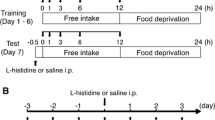Abstract
Naloxone (0.5–5 mg/kg) reduced both food and water intake in non-deprived male rats, tested in the dark phase of the light-dark cycles in their home cages. These effects were transient; food and water-intake were restored to control levels by the end of the 8-h test period. The effects were also not dose-related. Naloxone (1 and 5 mg/kg) also reduced water-intake in water-deprived and food-deprived animals, without altering food-intake. These results suggested that naloxone may exert a primary antidipsogenic action, that does not depend upon any suppression of feeding. A final experiment showed that naloxone can completely abolish the thirst produced by injection of a hypertonic saline solution. This experiment also demonstrated that naloxone could suppress feeding, even though food intake was markedly inhibited by the osmotic thirst stimulus. Hence, the activation of feeding responses (e.g. by food deprivation) is not a necessary condition for naloxone to suppress feeding. The implications of these results for the control of feeding and drinking responses are briefly considered.
Similar content being viewed by others
References
Amir S, Solomon M, Amit Z (1979) The effect of acute and chronic naloxone administration on motor activation in the rat. Neuropharmacology 18:171–173
Brands B, Thornhill JA, Hirst M, Gowdey CW (1979) Suppression of food intake and body weight gain by naloxone in rats. Life Sci 24:1773–1778
Brown DR, Holtzman SG (1979) Suppression of deprivation-induced food and water intake in rats and mice by naloxone. Pharmacol Biochem Behav 11:567–573
Cooper SJ (1980) Effects of enantiomers of oxazepam sodium hemisuccinate on water intake and antagonism of picrotoxin- or naloxone-induced suppression of drinking by chlordiazepoxide in the rat. Neuropharmacology (in press)
Fitzsimons JT (1971) The physiology of thirst: a review of the extraneural aspects of the mechanisms of drinking. In: Steller E, Sprague JM (eds) Progress in physiological psychology, vol 4. Academic Press, New York London, p 119
Frenk H, Rogers GH (1979) The suppressant effects of naloxone on food and water intake in the rat. Behav Neural Biol 26:23–40
Grandison K, Guidotti A (1977) Stimulation of food intake by muscimol and beta endorphin. Neuropharmacology 16:533–536
Holtzman SG (1974) Behavioral effects of separate and combined administration of naloxone and d-amphetamine. J Pharmacol Exp Ther 189:51–60
Holtzman SG (1975) Effects of narcotic antagonists on fluid intake in the rat. Life Sci 16:1465–1470
Holtzman SG (1979) Suppression of appetitive behavior in the rat by naloxone: lack of effect of prior morphine dependence. Life Sci 24:219–226
Maickel RP, Braude MC, Zabik JE (1977) The effects of various narcotic agonists and antagonists on deprivation-induced fluid consumption. Neuropharmacology 16:863–866
Margules DL, Moisset B, Lewis MJ, Shibuya H, Pert CB (1978) β-endorphin is associated with overeating in genetically obese mice (ob/ob) and rats (fa/fa). Science 202:988–991
Segal DS, Brown RB, Arnsten A, Derrington DC, Bloom FE, Guillemin R, Ling N (1979) Characteristics of β-endorphin-induced behavioural activation and immobilization. In: Usdin E, Bunney WE, Jr, Kline NS (eds) Endorphins in mental health research. Macmillan, London, p 307
Snyder SH, Matthysse S (1977) Opiate receptor mechanisms. Neurosci Res Program Bull 13:1–166
Stapleton J, Lind MD, Merriman VJ, Reid LD (1979) Naloxone inhibits diazepam-induced feeding in rats. Life Sci 24:2421–2426
Toates FM (1979) Water and energy in the interaction of thirst and hunger. In: Brown K, Cooper SJ (eds) Chemical influences on behaviour. Academic Press, London New York, p 135
Author information
Authors and Affiliations
Rights and permissions
About this article
Cite this article
Cooper, S.J. Naloxone: Effects on food and water consumption in the non-deprived and deprived rat. Psychopharmacology 71, 1–6 (1980). https://doi.org/10.1007/BF00433244
Received:
Accepted:
Issue Date:
DOI: https://doi.org/10.1007/BF00433244




